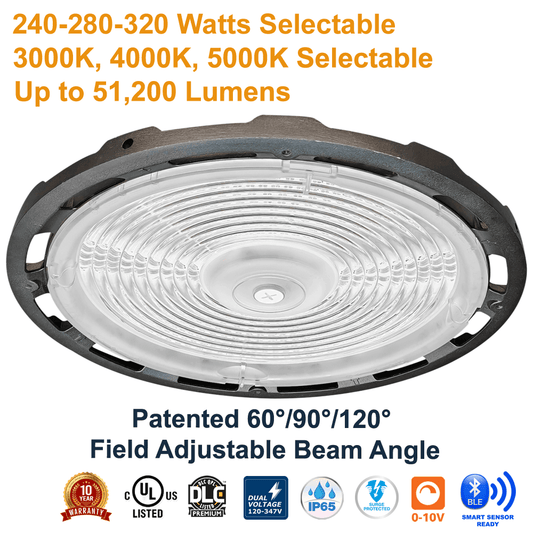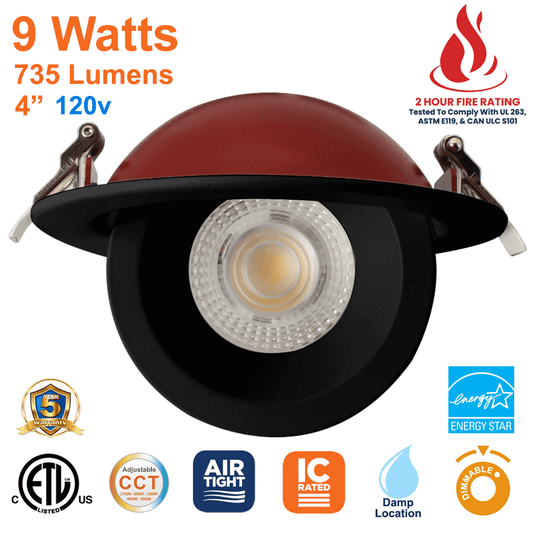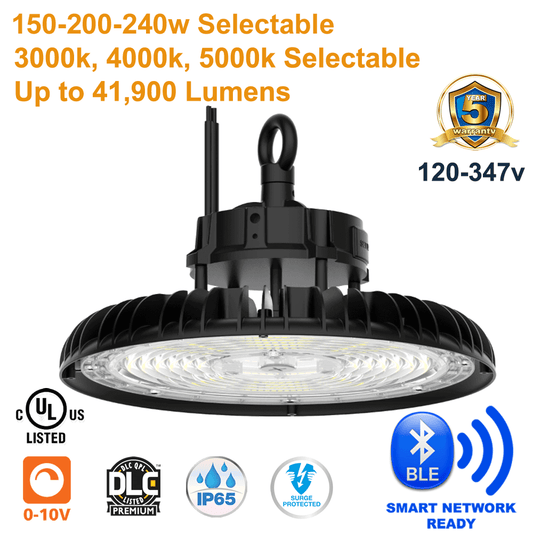In the realm of commercial lighting, a match of Herculean proportions is underway. Our contenders: High Bay LED Lights versus traditional lights. These titans battle for supremacy, but only one can reign victorious. Let's first decipher who our contenders are, and what distinguishes them from one another.
The Contenders: High Bay Light Varieties
To understand the battlefield, we must first clarify what exactly a high bay light is. Named for their optimal functionality in high ceiling environments (typically above 20 feet), these luminaires are designed to effectively illuminate large, expansive areas such as warehouses, factories, gyms, or recreation facilities. High bay lights come in three main forms: traditional, LED, and UFO LED High Bays.
Traditional high bay lights, such as Metal Halide high bays, have been around for decades, providing reliable illumination to countless spaces. Yet, as technology advanced, so did our contenders. LED high bay lights entered the ring, offering a more energy-efficient solution, while UFO high bay lights landed, boasting a sleeker design and remarkable efficacy.
Round One: What are LED High Bays?
The LED High Bay lights entered the scene to applause from energy-conscious businesses and environmentally-friendly enthusiasts alike. Emitting a powerful, directional light, these fixtures minimize wasted light, focusing brightness exactly where it's needed. With typical projected lifespans now far exceeding 50,000 hours, their durability far surpasses that of their traditional counterparts. If you've ever found yourself in a modern, well-lit warehouse, you've likely reaped the benefits of LED High Bays.
Another noteworthy player is the UFO High Bay LED light. Named for their flying saucer-like appearance, these fixtures are often more compact than their siblings, yet pack an equally impressive punch when it comes to light output and efficiency. Our blog post about them provides more insights.
Round Two: The Advantages of LED High Bay Lights
Switching to LED High Bay lights comes with a myriad of benefits. The first being their energy efficiency. LEDs use a fraction of the power of traditional lights, with up to 80% more efficiency. This shift results in drastic reductions to electricity costs and carbon footprints, making them the lighting solution of choice for businesses striving for sustainability.
Reliability is another key factor. As discussed in our comprehensive guide on high bay LED lights, these fixtures are designed to last. They shine bright for years, free from the need for constant maintenance and replacement, a major advantage over traditional lighting options.
Their impressive lifespan does raise a question though: Do LED high bay lights get dimmer over time? The short answer is, not really. While it's true that all light fixtures experience some degree of lumen depreciation, the rate at which this occurs in LEDs is significantly slower than in traditional bulbs. Thus, over their lifespan, LED high bay lights maintain their brightness far longer.
Round Three: Choosing the Right High Bay Lights
Choosing the right LED High Bay lights for your needs can feel like navigating a labyrinth. However, it becomes much simpler once you understand the factors to consider, such as your space's ceiling height, its square footage, the desired light intensity, and the specific tasks being performed under the lights.
Assuming a space of about 25 feet high, for instance, and seeking to maintain industry-standard brightness levels, you would need approximately one LED High Bay light for every 300 square feet of space. This, of course, is a rule of thumb and should be adjusted according to the specific needs of your facility. Consulting with a lighting expert like the ones at LED Network, can be invaluable in such situations.
Another variable in this equation is the implementation of Networked Lighting Controls. By intelligently adjusting lighting levels based on factors like occupancy or daylight, these systems can significantly reduce the energy usage of your LED High Bay lights, saving you even more on electricity costs.
Round Four: The Longevity of LED High Bay Lights
Our next discussion point in this showdown is longevity. How long do LED high bay lights last?
The answer: significantly longer than their traditional counterparts. LEDs, in general, boast an impressive lifespan, but when it comes to High Bay LED Lights, we're talking about an astounding 50,000 hours minimum.. That's over five years of continuous usage, or more than a decade under normal operation! More and more LED High Bays are now projected to last well over 100,000 hours.
To put it in perspective, traditional lighting solutions, such as HID (High Intensity Discharge) or fluorescent lights, typically last between 10,000 and 20,000 hours, making LEDs a clear winner in terms of longevity. For a more detailed exploration of their lifespan, check out our blog post on the subject.
Round Five: Do LED High Bay Lights Get Hot?
Let's set the record straight: All light fixtures emit some heat. However, one of the great benefits of LED technology is its superior heat management.
Traditional light fixtures convert a significant amount of energy into heat rather than light, which not only wastes energy but also makes them hot to the touch. LEDs, on the other hand, use energy far more efficiently, converting a larger portion into light. Therefore, while an LED high bay light will get warm during operation, it won't reach the same high temperatures as a traditional light, making it safer to handle and reducing the risk of accidental burns or fires.
Round Six: How Many LED High Bay Lights Do I Need?
Determining the number of LED high bay lights needed for your space is not as simple as it might seem. It depends on various factors such as the size of your area, the height of your ceiling, and the type of activities that will be taking place in the space.
As a rule of thumb, an area of 1,000 square feet with a ceiling height of about 20 feet would require approximately three to four high bay lights. However, for more accurate calculations and lighting designs, you should consider enlisting the help of professionals in recreation facility lighting.
Round Seven: How Can Networked Lighting Controls Enhance My LED High Bay Lights?
The addition of Networked Lighting Controls to your LED high bay lights can greatly enhance their functionality and efficiency. By allowing precise control over each light fixture, these systems can dynamically adjust lighting levels to suit the needs of the space at any given moment.
For example, if a warehouse is unoccupied, the system could dim or switch off the lights to save energy. Similarly, if daylight is streaming in through the windows, the system could lower the light output to maintain a consistent level of illumination.
Such dynamic lighting control can result in energy savings of up to 35% on top of the savings provided by switching to LED lighting, making it a valuable addition to any LED highbay lighting setup. Learn more about these revolutionary systems in our blog post on the subject.
Round Eight: Do LED High Bay Lights Get Dimmer Over Time?
Unlike traditional lights, which can drastically lose their brightness over time, LED lights depreciate far more slowly. This is because LEDs use semiconductors to produce light, which results in a more stable and reliable output over their lifespan. So, while LEDs do get slightly dimmer over time, it's usually a negligible amount until they reach the end of their life cycle.
To enhance the performance and lifespan of your LED high bay lights, consider using High Bay Sensors. These devices can provide real-time data about the operating conditions of your lights and can adjust their brightness based on environmental factors, such as ambient light or occupancy.
Round Nine: Choosing The Right LED High Bay Lights
Choosing the right LED high bay lights involves considering several key factors:
- Size of the Space: Larger spaces typically require higher-wattage lights. Be sure to accurately measure your space before making a decision.
- Ceiling Height: High bay lights are ideal for spaces with high ceilings (generally 20 feet or more). For lower ceilings, other lighting options might be more suitable.
- Type of Activity: Different activities require different levels of illumination. For example, a warehouse might require less light than a gymnasium. Take a look at our Gymnasium Lighting collection for lighting that caters to active environments.
- Light Quality: Pay attention to factors like colour temperature and colour rendering index (CRI). For more on colour temperature and its importance, read our informative article on the topic.
The Final Verdict: High Bay LED Lights vs Traditional Lights
So, who is the winner in this showdown? The answer is clear: High Bay LED Lights. They offer unparalleled efficiency, longevity, versatility, and safety compared to traditional lighting options.
Whether you are outfitting a large commercial space like a warehouse or looking to optimize the lighting in a high-traffic area like a gymnasium, high bay LED lights coupled with modern lighting controls are the superior choice.
Don't just take our word for it - explore the difference yourself with our broad selection of High Bay LED Lights and Networked Lighting Controls.
Enjoy the benefits of LED technology and take a step towards a brighter, more sustainable future with LED Network!



























